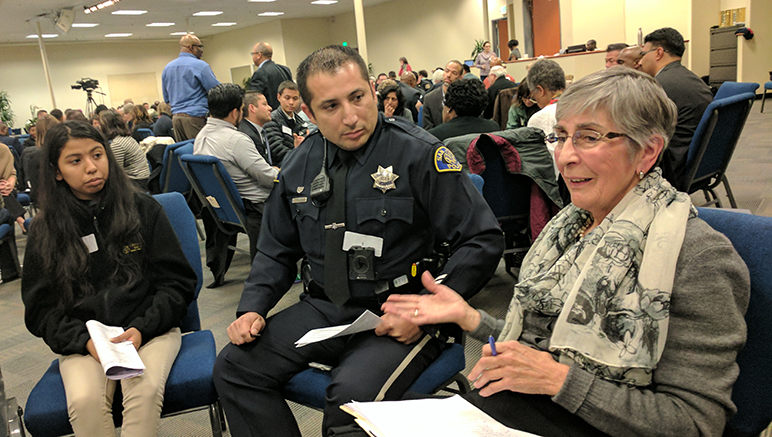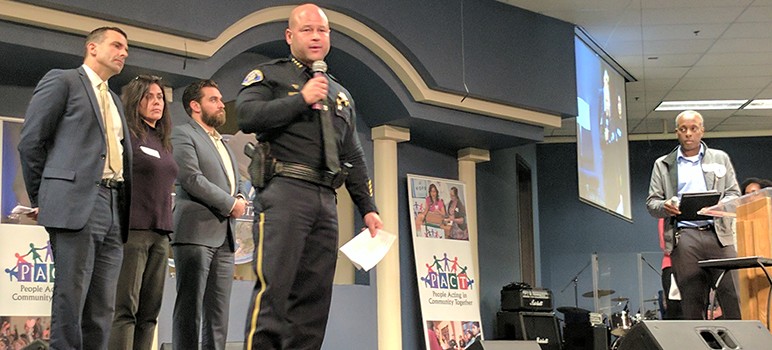San Jose’s mayor and some council members said they want greater oversight of local law enforcement and would support a ballot measure to expand the role of the city’s independent police watchdog.
Before a packed auditorium at Bible Way Christian Center Thursday night, Mayor Sam Liccardo said he supports placing such a voter initiative on the 2018 ballot.
“Back when the charter was amended, establishing our office in 1996, I think the IPA’s model was really the standard,” Independent Police Auditor Walter Katz told San Jose Inside. “But it’s been 20 years since then, and I think there’s some voices in the community that say it’s time to reconsider.”
Along with City Council members Magdalena Carrasco and Raul Peralez, the mayor and police Chief Eddie Garcia also promised to release public reports on use-of-force incidents, a practice that was discontinued in 2006.
“I know that one of the holdups right now has been the technology itself,” said Peralez, a former San Jose police officer. But, he added, “This is information that absolutely needs to be shared with the community.”
The commitments came at the end of a forum on how to mend the relationship between police and civilians whose faith in law enforcement is badly shaken. Hosted by People Acting in Community Together (PACT), the event drew roughly 300 attendees and a host of high-ranking law enforcement and elected officials.
Garcia opened the discussion by talking about how bias in law enforcement is an extension of entrenched structural racism.
“The reality is that we’re caught up in this wheel of the justice system, but the justice system starts well before that … [in our] child welfare system, our schools,” he said.
The department is trying to improve its internal oversight, the chief added. Part of that includes training officers on how to recognize their own biases. Garcia also apologized for any offense caused by a video released in November by the local police union. The minute-long clip released by the San Jose Police Officers’ Association highlighted the uptick in officer killings ended with declarations that “All Lives Matter” and “Blue Lives Matter,” slogans created to protest the Black Lives Matter movement.
“We’re not perfect,” Garcia said. “We will have bumps along the road, but in the end we need you to know that we are here for you.”
Speaking to issues of accountability at the regional level, Santa Clara County Supervisor Joe Simitian said he wants to install independent oversight of the jails and Sheriff’s Office, too. In the aftermath of Michael Brown’s killing at the hands of a police officer in Ferguson, Missouri, the supervisor pushed for a slate of accountability measures to prevent similar tragedies. Some of those changes include training sheriff’s deputies to recognize implicit bias and wear cameras to record their interactions in the line of duty.
In 2015, the fatal beating of Michael Tyree, a mentally ill inmate at San Jose’s Main Jail, brought greater urgency to those reform efforts and exposed alarming systemic dysfunction in county jails.
Dep. Roger Winslow, head of the union that represents sheriff’s deputies, agreed with Simitian that the Sheriff’s Office needs independent oversight of enforcement, administration and custody. His counterpart at the jail guard union, however, thought otherwise. Lt. Amy Le, president of the Correctional Peace Officers’ Association, said she’s against independent review of internal and external department complaints.
“I’m sorry,” Le said. “At this time, I cannot support that decision.”
Newly installed cameras capture events inside the jails, she added, and officers document every incident as they occur. That, in her and the union’s opinion, is enough.
“Give us a chance for transparency,” Le said. “The use-of-force system is changing. We are documenting everything.”
Between Garcia’s initial remarks and public declarations from other officials, the audience split into smaller groups, each assigned an officer who volunteered to hear them out. Elvira Obregon, a social worker and local activist, asked one officer to explain why so many viral videos show police escalating tensions to the point of violence.
“A lot of times in these videos, the situation doesn’t call for that level of force,” Obregon said. “We hear all this talk of de-escalation, but that’s not what’s we’re seeing.”
Officer Jose Montoya, a 17-year SJPD veteran, told her that he can’t speak for other agencies but stressed that those videos often tell just a fraction of the story.
“When police arrive, it’s because there’s a problem,”Montoya said. “It’s because there’s contact, somebody’s in crisis, somebody needs help or somebody broke the law.”
“You must admit that there’s some rotten apples in the bunch,” Obregon replied.
“Yes,” Montoya agreed, “as there is in any profession.”
“Would you be brave enough to call them out?” she asked.
“I would,” he said.

Officer Jose Montoya (center) listens as Carmen Johnson (right) talks about a negative interaction she had with a San Jose police officer.
This article has been updated.


Nonsense, you still have a useless individual getting $150,000 + for a rubber stamp. The City only wants to have control over cover ups and Civil Suit payouts.
We could solve all this nonsense if we just fast forward to firing all the white men and hiring nothing but brown women,
then everything will be just peachy
Haven’t heard anything from the San Jose Police Officers Association? Time to step up.
TIme to step up. Another one of the loud minority that gets 90% airtime. San Jose has no idea how good they have had it.
San Jose Mayor Commits to Expanding Police Oversight
Just remove the word ‘oversight’, and we’ll be good to go…
I think we should give less oversight to the IPA. Officers have body worn cameras now and they will tell the story. There will be less complaints. The complaints that do come in most likely can be addressed with training for particular officers. I don’t want my police force to be hamstrung by more red tape. I want them to make my community safe again.
In my opinion, this is just more voter pandering by the mayor.
FUN FACTS:
2014-2015 SJPD received 564,528 911 calls and made 100,579 field events (i.e. traffic stops). With all those citizen contacts the IPA and SJPD received 303 complaints. In percentage, that is .00045%. Of those 303 complaints citizens (and criminals) didn’t like the way they were talked to and didn’t think they should have been arrested at all.
In 2015 the IPA budget for six people was $1,249,223.
The IPA makes at least $178,000 a year.
The IPA went to 172 IPA presentation, community events, meet and greets
Once Cordell left the IPA position IPA complaints dropped from 51% to 39%
SJPD made 55,000 less field events (i.e. car stops) then 2010-2011 year.
Obviously if we can improve the complaint record of the SJPD by 12% by removing Ladoris Cordell we could reduce
complaints all together by removing three of the remaining IPA members. That being said we we will no longer be needing an IPA and can thereby shut it down saving the city a total of $1,249,223 per year.
This would make funds avalible to hire 8.328 more badly needed cops of any color.
There, that was fun and I’ve solved another one of our problems!
Five more days till Trump is President, are you all still here?
Why don’t we survey SJPD customer satisfaction?
Many departments use surveys and realize benefits. It’s inexpensive, provides an early warning system (IPA and Internal Affairs do not), provides benchmarks against other PDs, and pinpoints what’s working and what’s not.
Unlike the SJ Auditor or the Civil Grand Jury, IPA’s self-identified mission is to find fault – but not exemplary performance. Customer satisfaction surveys do both.
The SJ residents survey shows perception of safety has declined by about about 50% since 2011. See page 19 of Auditor’s 2015-2016 report http://www.sanjoseca.gov/DocumentCenter/View/63203
Most metrics have steadily and precipitously declined. ‘Would You Recommend Living in SJ’ has declined from 80% in 2011 to 51% in the last survey period.
Mayor Liccardo’s priorities are misguided.